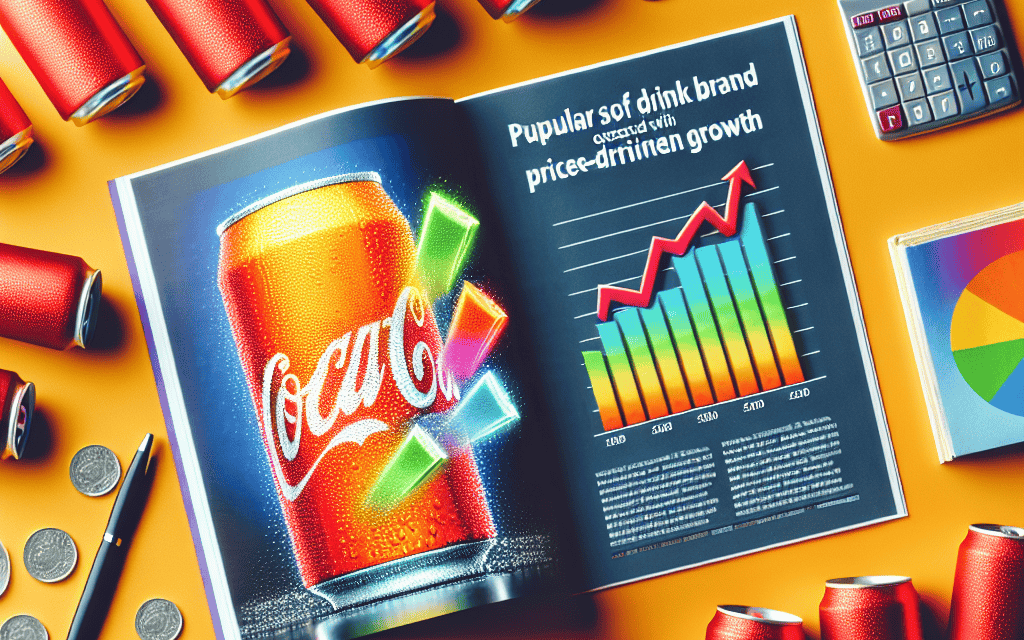“Coca-Cola Fizzes Past Q3 Expectations: Price Power Fuels Growth!”
Introduction
In the third quarter, Coca-Cola surpassed market expectations, driven primarily by strategic price increases that bolstered its revenue growth. The beverage giant reported a notable rise in sales, reflecting its ability to effectively navigate inflationary pressures and shifting consumer preferences. By leveraging its strong brand portfolio and implementing targeted pricing strategies, Coca-Cola successfully offset higher input costs and maintained robust profit margins. This performance underscores the company’s resilience and adaptability in a challenging economic environment, positioning it well for continued success in the competitive global beverage industry.
Coca-Cola’s Strategic Pricing Boosts Q3 Revenue
In the third quarter of the fiscal year, Coca-Cola has surpassed market expectations, reporting a notable increase in revenue driven primarily by strategic pricing adjustments. This development underscores the company’s adeptness at navigating the complexities of a challenging economic landscape, marked by fluctuating consumer demand and rising production costs. As inflationary pressures continue to impact the global economy, Coca-Cola’s ability to leverage pricing strategies effectively has proven instrumental in maintaining its competitive edge and ensuring robust financial performance.
The beverage giant’s decision to implement price hikes across various markets has been a pivotal factor in its recent success. By carefully calibrating these increases, Coca-Cola has managed to offset the rising costs of raw materials and transportation, which have been exacerbated by ongoing supply chain disruptions. This approach has not only safeguarded profit margins but also reinforced the company’s commitment to delivering value to its shareholders. Moreover, the strategic pricing adjustments have been executed with a keen awareness of consumer sensitivity, ensuring that demand remains resilient despite the higher price points.
In addition to price-driven growth, Coca-Cola’s diverse product portfolio has played a crucial role in bolstering its financial results. The company’s ability to offer a wide range of beverages, from traditional sodas to healthier options such as low-sugar and zero-calorie drinks, has enabled it to cater to evolving consumer preferences. This diversification strategy has been particularly effective in capturing market share in regions where health-conscious consumption is on the rise. By aligning its product offerings with consumer trends, Coca-Cola has not only enhanced its brand appeal but also strengthened its position in the global beverage industry.
Furthermore, Coca-Cola’s investment in marketing and innovation has been instrumental in sustaining its growth trajectory. The company has consistently demonstrated a commitment to engaging consumers through targeted advertising campaigns and strategic partnerships. These efforts have been complemented by a focus on product innovation, with the introduction of new flavors and packaging formats designed to attract and retain customers. By fostering a culture of innovation, Coca-Cola has ensured that its brand remains relevant and appealing in an increasingly competitive market.
The company’s strong performance in the third quarter also reflects its successful expansion into emerging markets, where rising disposable incomes and urbanization are driving increased demand for branded beverages. Coca-Cola’s strategic investments in these regions have enabled it to capitalize on growth opportunities and establish a solid foothold in key markets. This geographic diversification has not only contributed to the company’s revenue growth but also mitigated the impact of economic volatility in more mature markets.
Looking ahead, Coca-Cola remains optimistic about its prospects, with plans to continue leveraging its pricing power and expanding its product offerings. The company is also committed to advancing its sustainability initiatives, recognizing the growing importance of environmental responsibility in shaping consumer preferences. By prioritizing sustainable practices, Coca-Cola aims to enhance its brand reputation and ensure long-term success in an increasingly eco-conscious world.
In conclusion, Coca-Cola’s impressive third-quarter performance is a testament to its strategic acumen and adaptability in the face of economic challenges. Through effective pricing strategies, product diversification, and a focus on innovation, the company has not only exceeded market expectations but also reinforced its position as a leader in the global beverage industry. As it continues to navigate the complexities of the current economic environment, Coca-Cola’s commitment to delivering value to its stakeholders remains unwavering.
Analyzing Coca-Cola’s Q3 Financial Performance
Coca-Cola’s third-quarter financial performance has surpassed market expectations, driven primarily by strategic price adjustments that have bolstered revenue growth. As the global economy continues to navigate the complexities of inflationary pressures and shifting consumer behaviors, Coca-Cola’s ability to adapt its pricing strategy has proven to be a pivotal factor in its recent success. The company’s financial results for the third quarter reveal a robust increase in revenue, underscoring the effectiveness of its approach in maintaining profitability amidst challenging economic conditions.
In analyzing Coca-Cola’s Q3 performance, it is essential to consider the broader economic context in which these results were achieved. The global beverage industry has faced significant headwinds, including supply chain disruptions and fluctuating raw material costs. Despite these challenges, Coca-Cola has managed to implement price increases that have not only offset rising costs but also contributed to an enhanced revenue stream. This strategic maneuvering has allowed the company to maintain its competitive edge while ensuring that its products remain accessible to a broad consumer base.
Moreover, Coca-Cola’s success in the third quarter can be attributed to its diversified product portfolio, which has enabled the company to cater to a wide range of consumer preferences. By offering a variety of beverages, from traditional sodas to healthier options such as low-sugar and zero-calorie drinks, Coca-Cola has effectively captured a larger share of the market. This diversification strategy has been instrumental in driving sales growth, as it allows the company to appeal to health-conscious consumers while retaining its loyal customer base.
In addition to its pricing and product strategies, Coca-Cola’s investment in digital marketing and e-commerce platforms has played a crucial role in its Q3 performance. The company has leveraged technology to enhance its consumer engagement, utilizing data analytics to better understand consumer preferences and tailor its marketing efforts accordingly. This digital transformation has not only improved brand visibility but also facilitated more efficient distribution channels, thereby increasing sales and customer satisfaction.
Furthermore, Coca-Cola’s commitment to sustainability and corporate social responsibility has resonated well with consumers, particularly in an era where environmental concerns are increasingly influencing purchasing decisions. The company’s initiatives to reduce its carbon footprint and promote sustainable packaging have strengthened its brand image, fostering consumer loyalty and trust. This alignment with consumer values has undoubtedly contributed to the positive reception of its products, further driving revenue growth.
While Coca-Cola’s Q3 performance is commendable, it is important to acknowledge the potential challenges that lie ahead. The global economic landscape remains uncertain, with inflationary pressures and geopolitical tensions posing risks to future growth. However, Coca-Cola’s proactive approach to navigating these challenges, through strategic pricing, product diversification, and digital innovation, positions the company well to sustain its momentum in the coming quarters.
In conclusion, Coca-Cola’s third-quarter financial results highlight the effectiveness of its strategic initiatives in driving revenue growth amidst a complex economic environment. By leveraging price-driven growth, diversifying its product offerings, and embracing digital transformation, the company has successfully exceeded market expectations. As Coca-Cola continues to adapt to evolving consumer preferences and economic conditions, its commitment to innovation and sustainability will be key to maintaining its leadership position in the global beverage industry.
How Price Adjustments Impacted Coca-Cola’s Q3 Success
Coca-Cola’s recent financial performance in the third quarter has surpassed market expectations, largely driven by strategic price adjustments. This development highlights the company’s adeptness at navigating the complex landscape of global economic challenges, including inflationary pressures and fluctuating consumer demand. As the world grapples with economic uncertainties, Coca-Cola’s ability to leverage pricing strategies has proven instrumental in maintaining its competitive edge and ensuring robust financial health.
In the third quarter, Coca-Cola reported a notable increase in revenue, which can be attributed to its strategic decision to implement price hikes across various markets. This move, while initially met with skepticism, has ultimately paid off, as evidenced by the company’s impressive financial results. By carefully analyzing market conditions and consumer behavior, Coca-Cola was able to adjust its pricing strategy in a manner that not only offset rising production costs but also enhanced its profit margins. This approach underscores the importance of agility and foresight in the ever-evolving business landscape.
Moreover, Coca-Cola’s success in the third quarter can be linked to its ability to balance price increases with value delivery. The company has consistently focused on enhancing its product offerings, ensuring that consumers perceive added value despite the higher price points. This has been achieved through a combination of innovative marketing campaigns, product diversification, and a commitment to sustainability. By aligning its pricing strategy with consumer expectations and preferences, Coca-Cola has managed to retain customer loyalty while attracting new consumers, thereby expanding its market share.
Furthermore, the company’s strategic pricing adjustments have been complemented by its efforts to optimize operational efficiency. Coca-Cola has invested in advanced technologies and streamlined its supply chain processes, which have contributed to cost savings and improved productivity. These initiatives have not only mitigated the impact of rising input costs but have also enabled the company to reinvest in growth opportunities. As a result, Coca-Cola has been able to maintain a strong financial position, even in the face of economic headwinds.
In addition to its internal strategies, Coca-Cola’s success in the third quarter can also be attributed to favorable external factors. The gradual recovery of the global economy, coupled with the easing of pandemic-related restrictions, has led to increased consumer spending and a resurgence in demand for beverages. Coca-Cola has capitalized on this trend by expanding its distribution channels and enhancing its presence in emerging markets. This has allowed the company to tap into new revenue streams and further solidify its position as a global leader in the beverage industry.
Looking ahead, Coca-Cola’s performance in the third quarter serves as a testament to the effectiveness of its pricing strategy and operational excellence. However, the company remains vigilant in monitoring market dynamics and is prepared to adapt its approach as needed. By maintaining a focus on innovation, sustainability, and consumer engagement, Coca-Cola is well-positioned to navigate future challenges and continue its trajectory of growth.
In conclusion, Coca-Cola’s ability to exceed expectations in the third quarter is a reflection of its strategic acumen and resilience. Through thoughtful price adjustments and a commitment to delivering value, the company has successfully navigated a complex economic environment and emerged stronger. As Coca-Cola continues to evolve and adapt, it sets a benchmark for other companies seeking to thrive in an increasingly competitive global market.
Coca-Cola’s Growth Strategy: A Q3 Review

In the third quarter of the fiscal year, Coca-Cola has once again demonstrated its resilience and strategic acumen by exceeding market expectations, primarily driven by its adept pricing strategies. This performance underscores the company’s ability to navigate a challenging economic landscape marked by inflationary pressures and shifting consumer preferences. As the global economy continues to grapple with these challenges, Coca-Cola’s approach offers valuable insights into how established brands can maintain growth and profitability.
To begin with, Coca-Cola’s success in the third quarter can be attributed to its strategic decision to implement price increases across various markets. This move, while potentially risky in a price-sensitive environment, has proven effective in offsetting rising production costs and maintaining profit margins. By carefully calibrating these price adjustments, Coca-Cola has managed to strike a balance between sustaining consumer demand and ensuring financial stability. This approach highlights the importance of understanding market dynamics and consumer behavior, allowing the company to make informed decisions that align with its long-term objectives.
Moreover, Coca-Cola’s growth strategy is not solely reliant on pricing. The company has also focused on expanding its product portfolio to cater to evolving consumer tastes. In recent years, there has been a noticeable shift towards healthier beverage options, and Coca-Cola has responded by diversifying its offerings to include low-sugar and zero-sugar alternatives. This diversification not only broadens the company’s appeal but also positions it favorably in a market increasingly driven by health-conscious consumers. By investing in product innovation and development, Coca-Cola ensures that it remains relevant and competitive in a rapidly changing industry.
In addition to product diversification, Coca-Cola has also leveraged its global distribution network to enhance its market presence. The company’s extensive reach allows it to capitalize on growth opportunities in emerging markets, where rising disposable incomes and urbanization are driving increased demand for branded beverages. By strengthening its foothold in these regions, Coca-Cola is able to mitigate the impact of economic fluctuations in more mature markets. This strategic expansion underscores the importance of a robust distribution network in achieving sustainable growth.
Furthermore, Coca-Cola’s commitment to sustainability and corporate responsibility has played a crucial role in its continued success. As consumers become more environmentally conscious, companies are increasingly expected to demonstrate their commitment to sustainable practices. Coca-Cola has responded by setting ambitious goals for reducing its carbon footprint, improving water efficiency, and promoting recycling initiatives. These efforts not only enhance the company’s brand image but also resonate with consumers who prioritize sustainability in their purchasing decisions.
In conclusion, Coca-Cola’s impressive performance in the third quarter is a testament to its strategic foresight and adaptability. By implementing price-driven growth strategies, diversifying its product offerings, expanding its global reach, and committing to sustainability, the company has successfully navigated a complex economic environment. As Coca-Cola continues to evolve and innovate, it sets a benchmark for other companies seeking to achieve growth and resilience in an ever-changing market. This quarter’s results not only reflect Coca-Cola’s current success but also lay the groundwork for future achievements, ensuring that the company remains a formidable player in the global beverage industry.
The Role of Pricing in Coca-Cola’s Q3 Market Expansion
In the third quarter of the fiscal year, Coca-Cola has once again demonstrated its resilience and strategic acumen by exceeding market expectations, primarily through a well-calibrated pricing strategy. This achievement underscores the pivotal role that pricing plays in the company’s market expansion efforts, particularly in a challenging economic landscape marked by inflationary pressures and shifting consumer preferences. As the global economy grapples with these challenges, Coca-Cola’s ability to leverage pricing as a growth driver offers valuable insights into the dynamics of consumer goods markets.
To begin with, Coca-Cola’s strategic price adjustments have been instrumental in offsetting increased production costs, which have been exacerbated by supply chain disruptions and rising raw material prices. By carefully calibrating price increases, the company has managed to maintain its profit margins without significantly dampening consumer demand. This delicate balance is crucial, as it ensures that the brand remains accessible to a broad consumer base while also safeguarding its financial health. Moreover, Coca-Cola’s pricing strategy is not merely reactive but also proactive, as it anticipates market trends and consumer behavior shifts, allowing the company to stay ahead of the curve.
Furthermore, the company’s success in Q3 can be attributed to its nuanced understanding of regional market dynamics. Coca-Cola has adeptly tailored its pricing strategies to suit different geographic markets, taking into account local economic conditions, competitive landscapes, and consumer purchasing power. This localized approach has enabled the company to optimize its pricing models, ensuring that they resonate with consumers in diverse markets. For instance, in regions where economic recovery is more robust, Coca-Cola has been able to implement more significant price increases, whereas in markets facing economic headwinds, the company has adopted a more conservative pricing approach.
In addition to regional considerations, Coca-Cola’s product diversification strategy has also played a crucial role in its Q3 performance. By expanding its portfolio to include a wider range of beverages, from traditional sodas to health-conscious options like low-sugar and zero-calorie drinks, the company has been able to cater to evolving consumer preferences. This diversification not only broadens Coca-Cola’s appeal but also provides additional pricing flexibility. Premium products, for example, can command higher price points, contributing to overall revenue growth without alienating cost-sensitive consumers.
Moreover, Coca-Cola’s investment in brand equity and marketing has reinforced its pricing power. The company’s iconic brand image and strong consumer loyalty have allowed it to implement price increases with minimal resistance. By continuously engaging with consumers through innovative marketing campaigns and maintaining a strong presence across various media platforms, Coca-Cola has strengthened its brand perception, which in turn supports its pricing strategies.
In conclusion, Coca-Cola’s impressive Q3 performance highlights the critical role of pricing in driving market expansion. Through a combination of strategic price adjustments, regional market tailoring, product diversification, and robust brand management, the company has successfully navigated a complex economic environment. As Coca-Cola continues to refine its pricing strategies, it sets a benchmark for other consumer goods companies seeking to achieve sustainable growth in an increasingly competitive global market. This case study serves as a testament to the power of strategic pricing as a tool for market expansion and financial resilience.
Key Takeaways from Coca-Cola’s Q3 Earnings Report
Coca-Cola’s third-quarter earnings report has captured the attention of investors and market analysts alike, as the beverage giant surpassed expectations through strategic price-driven growth. The company’s performance in this quarter underscores its ability to navigate a challenging economic landscape, marked by inflationary pressures and shifting consumer preferences. As the global economy continues to grapple with these challenges, Coca-Cola’s results offer valuable insights into how large corporations can adapt and thrive.
In the third quarter, Coca-Cola reported a notable increase in revenue, driven primarily by strategic price adjustments across its product portfolio. This approach allowed the company to offset rising costs associated with raw materials and supply chain disruptions. By carefully calibrating price increases, Coca-Cola managed to maintain consumer demand while protecting its profit margins. This delicate balance between pricing and demand is a testament to the company’s deep understanding of its market dynamics and consumer behavior.
Moreover, Coca-Cola’s success in this quarter can be attributed to its diversified product offerings and global reach. The company has continued to expand its portfolio beyond traditional carbonated beverages, tapping into the growing demand for healthier and more sustainable options. This diversification strategy has not only broadened Coca-Cola’s consumer base but also mitigated risks associated with changing consumer preferences. By investing in product innovation and expanding its presence in emerging markets, Coca-Cola has positioned itself to capture growth opportunities in various regions.
In addition to its product strategy, Coca-Cola’s focus on digital transformation has played a crucial role in its third-quarter success. The company has leveraged digital tools and data analytics to enhance its supply chain efficiency and improve customer engagement. By adopting a data-driven approach, Coca-Cola has been able to respond swiftly to market changes and optimize its operations. This digital transformation has also enabled the company to personalize its marketing efforts, thereby strengthening its brand loyalty and customer retention.
Furthermore, Coca-Cola’s commitment to sustainability has resonated well with consumers and investors alike. The company has made significant strides in reducing its environmental footprint, with initiatives aimed at improving water efficiency, reducing carbon emissions, and promoting recycling. These efforts have not only enhanced Coca-Cola’s brand image but also aligned with the growing consumer demand for environmentally responsible products. As sustainability becomes an increasingly important factor in consumer decision-making, Coca-Cola’s proactive approach in this area is likely to yield long-term benefits.
While the third-quarter results are encouraging, Coca-Cola remains vigilant about the challenges that lie ahead. The company acknowledges the ongoing uncertainties in the global economy, including potential fluctuations in commodity prices and geopolitical tensions. However, Coca-Cola’s robust financial performance in this quarter provides a strong foundation for navigating these uncertainties. By continuing to focus on strategic pricing, product diversification, digital transformation, and sustainability, Coca-Cola is well-positioned to sustain its growth momentum.
In conclusion, Coca-Cola’s third-quarter earnings report highlights the effectiveness of its strategic initiatives in driving price-driven growth. The company’s ability to adapt to changing market conditions, coupled with its commitment to innovation and sustainability, has enabled it to exceed expectations in a challenging economic environment. As Coca-Cola continues to execute its growth strategy, it serves as a compelling example of how large corporations can successfully navigate the complexities of the modern business landscape.
Coca-Cola’s Q3 Results: A Deep Dive into Price-Driven Growth
Coca-Cola’s third-quarter results have surpassed market expectations, driven primarily by strategic price adjustments that have bolstered revenue growth. As the global economy continues to grapple with inflationary pressures, Coca-Cola has adeptly navigated these challenges by implementing price increases across its product lines. This approach has not only offset rising production costs but also contributed to a notable increase in the company’s overall revenue. Consequently, Coca-Cola’s performance in the third quarter has been a testament to its robust pricing strategy and its ability to adapt to an ever-evolving economic landscape.
In examining the factors behind Coca-Cola’s impressive third-quarter performance, it is essential to consider the broader economic context. Inflation has been a persistent concern for businesses worldwide, with rising costs of raw materials, transportation, and labor impacting profit margins. In response, Coca-Cola has strategically raised prices, a move that has been met with minimal resistance from consumers. This price-driven growth has been instrumental in maintaining the company’s profitability, even as it faces the same economic headwinds that have challenged many of its peers.
Moreover, Coca-Cola’s ability to exceed expectations in the third quarter can also be attributed to its diversified product portfolio. The company has continued to innovate and expand its offerings, catering to a wide range of consumer preferences. From traditional carbonated beverages to healthier options such as low-sugar and zero-calorie drinks, Coca-Cola has successfully tapped into various market segments. This diversification has not only helped mitigate the impact of price increases on consumer demand but has also positioned the company to capture growth opportunities in emerging markets.
In addition to its pricing strategy and product diversification, Coca-Cola’s strong brand equity has played a crucial role in its third-quarter success. The company’s iconic brand, recognized and trusted by consumers worldwide, has allowed it to implement price increases without significantly affecting demand. This brand loyalty has been a key factor in sustaining sales volumes, even as prices have risen. Furthermore, Coca-Cola’s extensive distribution network has ensured that its products remain accessible to consumers, further reinforcing its market position.
While Coca-Cola’s third-quarter results have been impressive, it is important to acknowledge the challenges that lie ahead. The global economic environment remains uncertain, with inflationary pressures showing no signs of abating in the near term. As such, Coca-Cola will need to continue leveraging its pricing power and brand strength to navigate these challenges effectively. Additionally, the company must remain vigilant in monitoring consumer behavior and preferences, ensuring that its product offerings remain relevant and appealing.
In conclusion, Coca-Cola’s third-quarter performance has been a remarkable demonstration of its ability to adapt and thrive in a challenging economic environment. Through strategic price adjustments, product diversification, and leveraging its strong brand equity, the company has successfully exceeded market expectations. As it moves forward, Coca-Cola will need to maintain its focus on these key areas to sustain its growth trajectory and continue delivering value to its shareholders. The company’s success in the third quarter serves as a reminder of the importance of strategic agility and resilience in the face of economic uncertainty.
Q&A
1. **What were Coca-Cola’s Q3 earnings results?**
Coca-Cola reported earnings that exceeded analysts’ expectations, driven by strategic price increases.
2. **How did Coca-Cola achieve growth in Q3?**
The growth was primarily driven by price increases across various markets, which helped offset any volume declines.
3. **What was the impact of price increases on Coca-Cola’s sales?**
The price increases led to higher revenue, demonstrating the brand’s pricing power and consumer willingness to pay more.
4. **Did Coca-Cola experience any volume changes in Q3?**
While there were some volume declines in certain regions, the overall impact was mitigated by the increased pricing strategy.
5. **How did Coca-Cola’s Q3 performance compare to market expectations?**
Coca-Cola’s performance exceeded market expectations, showcasing strong financial management and strategic pricing.
6. **What was the market reaction to Coca-Cola’s Q3 results?**
The market reacted positively, with Coca-Cola’s stock seeing an uptick following the announcement of the better-than-expected results.
7. **What are Coca-Cola’s future growth strategies following Q3?**
Coca-Cola plans to continue leveraging its pricing strategy while focusing on expanding its product portfolio and enhancing operational efficiencies.
Conclusion
Coca-Cola’s third-quarter performance surpassed expectations, primarily driven by strategic price increases that bolstered revenue growth. Despite potential challenges such as fluctuating consumer demand and economic uncertainties, the company’s ability to effectively implement pricing strategies without significantly impacting sales volume highlights its strong brand equity and market positioning. This approach not only enhanced profitability but also demonstrated Coca-Cola’s resilience and adaptability in navigating a dynamic market environment. Overall, the results underscore the company’s robust operational execution and its capacity to leverage pricing power to sustain growth momentum.





